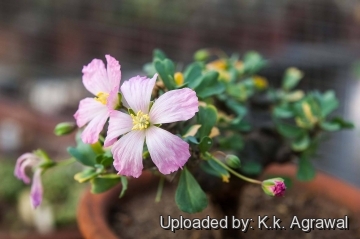Accepted Scientific Name: Monsonia patersonii DC.
Prodr. [A. P. de Candolle] 1: 639. 1824 [mid Jan 1824] DC. et al.

Sarcocaulon patersonii (Monsonia patersonii) Photo by: K.k. Agrawal
Origin and Habitat: Namibia (rom Rosh Pinah to Luderitz) and South Africa (Northern Cape Province, coastal zone of Richtersveld)
Habitat: Monsonia patersoniiSN|27997]]SN|27997]] grows holding forth against the wind-blown sand, on very shallow soils on rocky ground on the crests of sandy hillocks and in cracks in igneous rocks from the coast to some km inland in a community, almost exclusively composed of perennial species including Salsola zeyheri, Cephalophyllum ebractreatum, Juttadinteria deserticolaSN|11588]]SN|11588]], Pteronia glabrata and Euphobia verruculosa. In the same area it is also possible to find Aloe variegata, Anacampseros papyraceaSN|11043]]SN|11043]], and Crassula tectaSN|32661]]SN|32661]].
Synonyms:
See all synonyms of Monsonia patersonii
back
Accepted name in llifle Database:Monsonia patersonii DC.Prodr. [A. P. de Candolle] 1: 639. 1824 [mid Jan 1824]Synonymy: 3
back
Common Names include:
ENGLISH: Bushman's candle, Candle Bush
AFRIKAANS (Afrikaans): Boesmanskers, Heldoring, Kersbossie, Maagdoring,
Description: Monsonia patersoniiSN|27997]]SN|27997]], best known as Sarcocaulon patersoniiSN|27995]]SN|27995]], is a spiny, erect to spreading-ascending, succulent shrub or shrublet up to 0.5 m tall. It is perhaps the most remarkable of all the species of Sarcocaulon, itself an intriguing genus in the Geraniaceae. This species has wedge shaped leaves and the large flowers bloom in a variety of colours that can transform the landscape beautifully into a magnificent desert flower show. Colours range from dark pink to almost white. It was introduced in cultivation in Europe in1827. This plant has a thick, waxy bark to protect it from sand storms. This bark burns quite easily, albeit with a lot of smoke, giving rise to the common name of 'Bushman's candle'. It produces an incense-like odour when burned.
Roots: Woody tuberous main root.
Stems: Long-lived, fleshy and stiff. Branches usually more than 10 mm wide.
Leaves: Deciduous, oblong wedge shaped, or narrowly to broadly obovate, 5-26 mm long, 4-16 mm broad, glabrous, blunt entire some of them are almost sessile others on short petioles. The petioles are slowly transformed into spine.
Spines: Thick and straight, 2-5 blunt stalks in axils of spines.
Flowers: Hermaphrodite, hypogynous, solitary, about 25 mm in diameter with 5 petals and 5 sepals. Petals 15-30 mm long, rose, pale magenta or purple. Peduncles spinescent.
Remarks: This particular species is also confused with some of the other species of Sarcocaulon. Identification is easier once both flowers and leaves are evident.
Bibliography: Major references and further lectures
1) Albers F. “Monsonia” in:Urs Eggli “Illustrated Handbook of Succulent Plants: Dicotyledons” Springer Science & Business Media, 2002
2) Jean-André Audissou “The genus Sarcocaulon (De Candolle) Sweet (1826)” CACTUS-AVENTURES International N° 70
3) Moffett R. O. “The genus Sarcocaulon” in Bothalia Vol. 12, N°. 4 (1979) : 581-612.
4) Williamson G. : “Richtersveld” 168-169 (2000)
5) Alan Dean Foster “The Sum of Her Parts” Random House LLC, 27/nov/2012
6) Mrs. Loundon (Jane) “The Ladies' Flower-garden of Ornamental Greenhouse Plants” William Smith, 1848
7) George Don “A General System of Gardening and Botany” Volume 1 Rivington, 1831
8) R. M. Cowling, D. M. Richardson, S. M. Pierce “Vegetation of Southern Africa” Cambridge University Press, 01/Apr/2004
9) François Odendaal, Helen Suich “Richtersveld: The Land and Its People” Struik, 01/Jan/2007
10) David Fleminger “The Richtersveld Cultural and Botanical Landscape: Including Namaqualand” 30° South Publishers, 2008
 Sarcocaulon patersonii (Monsonia patersonii) Photo by: K.k. Agrawal
Sarcocaulon patersonii (Monsonia patersonii) Photo by: K.k. AgrawalSend a photo of this plant.The gallery now contains thousands of pictures, however it is possible to do even more. We are, of course, seeking photos of species not yet shown in the gallery but not only that, we are also looking for better pictures than those already present.
Read More... Cultivation and Propagation: Monsonia patersoniiSN|27997]]SN|27997]] is a decorative plant which has the fame to be difficult to care properly in cultivation, however it is relatively easily grown species, very suitable for bonsai. Seed-grown plants thrive and flower prolifically in cultivation while imported specimens rarely produce an extensive new root system and flower sporadically, but survive for many years.
Soil: The substrate must be very well draining and rather mineral in composition with at least 75% of pumice and lava grit.
Exposure: They require direct sunlight when in full growth, while a filtered exposition is best during the hottest period of summer, when the plants enter in their dormancy phase. They always grow best in positions where they receive long periods of strong sunlight.
Watering: They need to be regularly watered every 6 to 10 days whilst they are in active growth and and producing leaves, occasionally during dormancy. In cultivation it appear best not to let plants go into dormancy and to water year round. Nevertheless even in habitat the Sarcocaulons appear to be opportunistic and respond to precipitation events when they occur. As soon as the foliage starts to show signs of yellowing or withering, water should be withheld. It is very important that there is plenty of free air circulation around cultivated plants and also that they are not overwatered.
Temperature requirements: It is advised to maintain plants at a minimal temperature of 8°C during the winter.
Propagation: All sarcocaulon species are readily grown from seeds. Seeds should be sown just under the surface of the soil, in large seed trays or plastic pots. They should be planted out into individual containers when they are about two years old. The most dangerous period for seedling is in summer. They need to be kept dry whilst dormant but at the same time their trunk do not withstand continual drought. The seedlings adapt to the climate where they are grown and develop a vigorous root system. Propagation by cutting is rarely satisfactory and often cutting rarely branch out.











